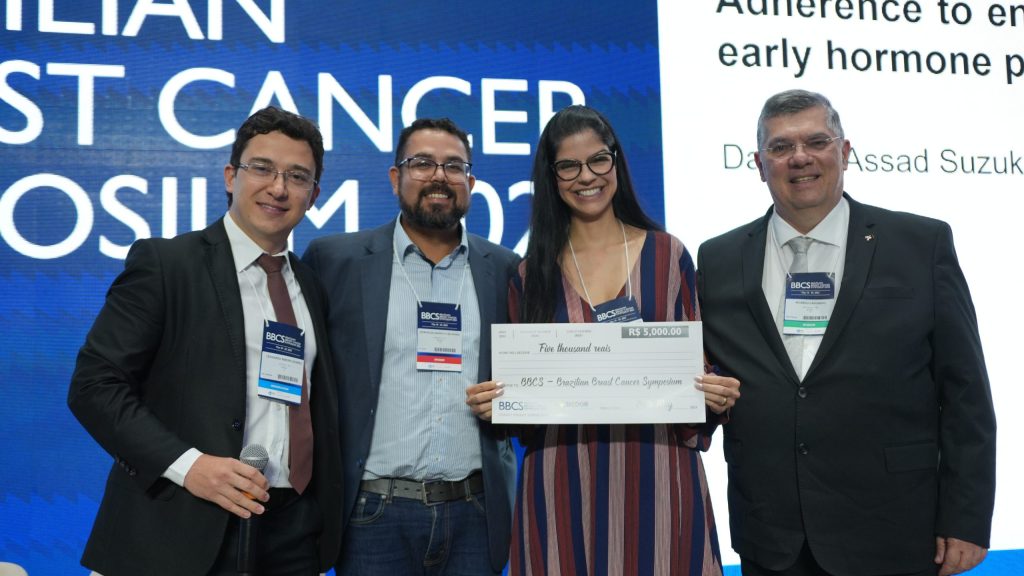
DISPARITY IN ACCESS TO ANTI-HER-2 THERAPIES IN NEOADJUVANT CHEMOTHERAPY: A PROGNOSTIC ANALYSIS BASED ON REAL WORLD DATA BETWEEN PUBLIC AND PRIVATE SYSTEMS IN BRAZIL
Marcelo Antonini1, 2; Andre Mattar3,4; Isabela Bastos Maia1; Andressa Gonçalves Amorim3; Marina Diogenes Teixeira3; Felipe Zerwes5; Denise Joffily Pereira da Costa Pinheiro1; Reginaldo Guedes Coelho Lopes1
1Mastology Department of Hospital do Servidor Público Estadual, São Paulo, Brazil.
2Preceptor of Mastology of University of São Paulo City (UNICID), São Paulo, Brazil.
3Mastology Department of Women’s Health Hospital, São Paulo, Brazil.
4Breast Surgeon at Oncoclínicas, São Paulo, Brazil.
5Mastology Department of Medical Scholl of PUC-RS., Porto Alegre, Brazil.
Objective: The aim of this study is to evaluate the impact of disparities in the use of trastuzumab in the neoadjuvant chemotherapy (NAC) within the Brazilian public health system on pathological complete response (pCR), overall survival (OS), and disease-free survival (DFS). Methodology: A retrospective, multicenter cohort study was conducted with female patients older than 18 years, diagnosed with non-metastatic, HER-2 positive breast cancer, who underwent NAC. The study took place at the Hospital Pérola Byington (PEROLA), serving the Unified Health System, and the Hospital do Servidor Público Estadual (HSPE), catering to public employees of the State of São Paulo, thus considered a private facility. pCR was defined as the absence of any residual invasive or in situ tumors in the breast and axillary nodes. Being an exploratory study based on real-world data (RWD), no confirmatory hypotheses were formulated; hence, there was no need for adjustments for multiple comparisons. OS and DFS were estimated using the Kaplan-Meier method over a period of five years. Results: Between 2011 and 2020, 381 patients at PEROLA and 78 patients at HSPE were treated with NAC for HER-2 positive BC. Access to Trastuzumab was higher at HSPE than at PEROLA (83.4% vs 60.0% p < 0.0-01). The rate of pCR in patients who used Trastuzumab was significantly higher in both institutions, PEROLA (54.3% vs 26.4% p < 0.0001) and at HSPE (52.7% vs 26.4% p < 0.0001). The OS of HER-2+ patients with pCR at HSPE was higher than at PEROLA with a significant difference (80% vs 61% log rank p < 0.0001) and the DFS was also superior at HSPE with a significant difference (89% vs 67% with log rank p < 0.0001). Conclusion: In conclusion, we can demonstrate, with RWD, that disparity in access to trastuzumab in NAC between the public and private healthcare systems are negatively impacting clinical outcomes and patient survival, highlighting the need for measures to ensure equity in cancer treatment. Addressing this issue is crucial for improving oncological care and the quality of life for patients.
Keywords: breast cancer, neoadjuvant chemotherapy, disparity, equity, trastuzumab, overall survival, disease free survival.

ADHERENCE TO ENDOCRINE ADJUVANT THERAPY IN WOMEN WITH EARLY HORMONE POSITIVE BREAST CANCER
Daniele Assad Suzuki¹, Danielle Laperche dos Santos², Anna Luiza Galvão³, Sulene Cunha Souza Oliveira4, Cristiano de Pádua Souza5, Amanda Guimarães Castro Custódio¹, Romualdo Barroso-Sousa6
¹ Hospital Sírio Libanês|Brasília|Distrito Federal|Brazil
² Hemolabor|Goiânia|Goiás|Brazil
³ UniCeub|Brasília|Distrito Federal|Brazil
4 Liga de Câncer de Natal|Natal|Rio Grande do Norte|Brazil
5 Hospital de Amor|Barretos|São Paulo|Brazil
6 Hospital Brasília, DASA Oncologia|Brasília|Distrito Federal|Brazil
Objective: This study aims to evaluate adherence to adjuvant endocrine therapy in woman with early breast cancer and explore its relationships with patients’ clinical and social characteristics and site of treatment. Methodology: Women with a past history of early-stage estrogen-receptor positive invasive carcinoma of the breast on adjuvant endocrine therapy for at least 6 months were invited to participate of this study. Adherence was assessed with questionnaire MMAS-8. Demographic and clinical information were reviewed from medical records. Data collection performed using RedCap software and statistical analyzes were performed on the software R (R Core Team (2022). Results: From June 2021 to March 2023, a total of 212 patients were recruited in 6 institutions. Median age was 56 years. 29,2% were black. 24,1% were premenopause. 38,2% had stage I disease. 65,1% received chemotherapy. 16,5% received HER2 blockade. Mean duration of endocrine therapy use was 3,7 years. 115 patients (54,2%) used aromatase inhibitors. 24 patients (11,4%) had low adherence, 76 (365) had intermediate and 111 (52,6%) had high adherence to adjuvant endocrine therapy. There is a tendence that more postmenopausal women were classified in high adherence grupo than premenopausal women (55.9% vs 42% p=0,19). There is a tendence that more woman in public service had high adherence than woman in private service (59.3% vs 50.3% p=0.07). There was no difference in adherence in relation to ethinicity, type/duration of endocrine treatment. Conclusion: This study for the first time show that high adherence to endocrine therapy only happens in 52.6% of patients, lower than reported in previous studies. This result draws attention because it can compromise survival. We will continue the recruitment of patients in the private service and in the public service to assess the rate of adherence in a larger population and the relationship with demographic characteristics.
Keywords: Hormone Therapy; Breast Cancer; Medication Adherence